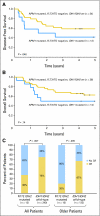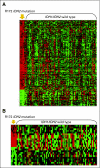IDH1 and IDH2 gene mutations identify novel molecular subsets within de novo cytogenetically normal acute myeloid leukemia: a Cancer and Leukemia Group B study
- PMID: 20368543
- PMCID: PMC2881719
- DOI: 10.1200/JCO.2009.27.3730
IDH1 and IDH2 gene mutations identify novel molecular subsets within de novo cytogenetically normal acute myeloid leukemia: a Cancer and Leukemia Group B study
Abstract
PURPOSE To analyze the frequency and associations with prognostic markers and outcome of mutations in IDH genes encoding isocitrate dehydrogenases in adult de novo cytogenetically normal acute myeloid leukemia (CN-AML). PATIENTS AND METHODS Diagnostic bone marrow or blood samples from 358 patients were analyzed for IDH1 and IDH2 mutations by DNA polymerase chain reaction amplification/sequencing. FLT3, NPM1, CEBPA, WT1, and MLL mutational analyses and gene- and microRNA-expression profiling were performed centrally. Results IDH mutations were found in 33% of the patients. IDH1 mutations were detected in 49 patients (14%; 47 with R132). IDH2 mutations, previously unreported in AML, were detected in 69 patients (19%; 13 with R172 and 56 with R140). R172 IDH2 mutations were mutually exclusive with all other prognostic mutations analyzed. Younger age (< 60 years), molecular low-risk (NPM1-mutated/FLT3-internal tandem duplication-negative) IDH1-mutated patients had shorter disease-free survival than molecular low-risk IDH1/IDH2-wild-type (wt) patients (P = .046). R172 IDH2-mutated patients had lower complete remission rates than IDH1/IDH2wt patients (P = .007). Distinctive microarray gene- and microRNA-expression profiles accurately predicted R172 IDH2 mutations. The highest expressed gene and microRNAs in R172 IDH2-mutated patients compared with the IDH1/IDH2wt patients were APP (previously associated with complex karyotype AML) and miR-1 and miR-133 (involved in embryonal stem-cell differentiation), respectively. CONCLUSION IDH1 and IDH2 mutations are recurrent in CN-AML and have an unfavorable impact on outcome. The R172 IDH2 mutations, previously unreported in AML, characterize a novel subset of CN-AML patients lacking other prognostic mutations and associate with unique gene- and microRNA-expression profiles that may lead to the discovery of novel, therapeutically targetable leukemogenic mechanisms.
Conflict of interest statement
Authors' disclosures of potential conflicts of interest and author contributions are found at the end of this article.
Figures


References
-
- Estey E, Döhner H. Acute myeloid leukaemia. Lancet. 2006;368:1894–1907. - PubMed
-
- Farag SS, Ruppert AS, Mrózek K, et al. Outcome of induction and postremission therapy in younger adults with acute myeloid leukemia with normal karyotype: A Cancer and Leukemia Group B study. J Clin Oncol. 2005;23:482–493. - PubMed
-
- Estey E. Acute myeloid leukemia and myelodysplastic syndromes in older patients. J Clin Oncol. 2007;25:1908–1915. - PubMed
Publication types
MeSH terms
Substances
Grants and funding
- U10 CA033601/CA/NCI NIH HHS/United States
- U24 CA114725/CA/NCI NIH HHS/United States
- U10 CA101140/CA/NCI NIH HHS/United States
- P30 CA016058/CA/NCI NIH HHS/United States
- CA77658/CA/NCI NIH HHS/United States
- CA31946/CA/NCI NIH HHS/United States
- CA140158/CA/NCI NIH HHS/United States
- CA33601/CA/NCI NIH HHS/United States
- P50 CA140158/CA/NCI NIH HHS/United States
- CA16058/CA/NCI NIH HHS/United States
- CA101140/CA/NCI NIH HHS/United States
- U10 CA077658/CA/NCI NIH HHS/United States
- U10 CA031946/CA/NCI NIH HHS/United States
- R21 CA129657/CA/NCI NIH HHS/United States
- CA129657/CA/NCI NIH HHS/United States
- CA114725/CA/NCI NIH HHS/United States
LinkOut - more resources
Full Text Sources
Other Literature Sources
Medical
Molecular Biology Databases
Miscellaneous

